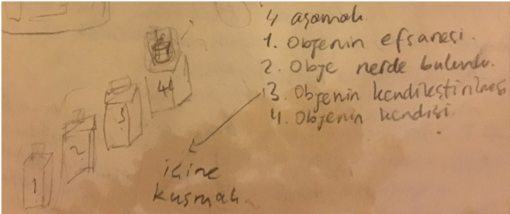filmix
art proposal
“Pass this on” is a quadripartite art installation consisting 2 videos, 2 photographs and a ready-made object. The project mainly focuses on the relationship between the real and the representation. The ready-made object, a ceramic water jug, is presented with 2 videos constructing an experimental narrative which goes back and forth between fiction and non-fiction and 2 photos of the artists interacting with the object. The mythical narrative which the videos convey will use conventional non-fiction film grammar and the photographs will have casual aesthetics.
The first video is a documentary about the history and the myth of the object. The documentary tells the story of a ceramic water jug which brings death onto its possessor. The jug randomly and mysteriously travels and designates its owner, and the owner passes it on to the next one before the foretold death. The exact timing of the death is unknown. This story is completely fictional however we plan to mimic and reference actual myths in the video. References will include ancient crematory urns, sacred pottery of ancient agricultural societies, the Zoroastrian tradition of making wine in a ceramic amphora to a newborn for it to be poured up onto the its grave.
The second video will be a testimonial of Murat Abar. Murat Abar is the name of the antiquarian that gifted us the ceramic water jug that will be exhibited in the project. He lives and works at Balat. As he tells, this jug was gifted to him from a friend in France and when he learnt that we were looking for a similar object for this project he decided to gift it to us. This real story of the jug’s journey inspired us to create a myth about an object that designates its own possessor like faith. In the video, he explains this transfer of the object with a focus on randomness, trade beyond capitalist conventions and the uniqueness of the object from the point of view of an antique expert. The video is in the traditional talking head testimony format with occasional views from various antiquarian shops of Balat. The narrative of this video is non-fictional. This video portrays the object as a merry gift, contrary to the previous video which creates a dark myth surrounding the object.
The third and forth parts of the installation are photographs of us, separately, with the object. They concentrate on the fact that us, as the artists of this work, currently are in the possession of the object. This will create a personal relationship between us and the object and us and the spectator.
Standing in the middle of the 4 white cylindrical pedestals which contains QR codes for the 4 visual media, will stand a taller pedestal that the object itself stands on. By exhibiting this mythical object we will be sharing the ownership of the jug and the death with the spectator. Death, as being the fundamental property of existence, is already shared amongst everyone, this projects further illustrates the concept. The use of QR codes requires the spectator to be active during the experience moreover, with viewing the visual media through the same screen that we spend our hours looking at, the project occupies a personal space which further enhances the identification process. The shared ownership of death, the ceramic water jug and the project is again presented with this occupation of the spectators personal space.
The project questions the relationship between the reality and the image of an object. The image is presented through visual media that surrounds and prevents the viewer from getting closer to the object. The curtain between the 4 shorter pedestals acts both as a projection space and a boundary. The spectator cannot directly interact with the object, they can only see it from a distance and gain information about it from the people that actually get involved with the object. This physical distance between the object and the spectator echoes in the distance between the presented irrational narrative of the visual media and the rational modern man. The spectator is challenged to take a stand whether they believe in the story or not.
November 20, 2017 / Eyüp
I learned that the concept of the exhibition was “Öteberi”. I was getting interested in thrift shops and antique auctions at that time so I thought designing an installation with a ready-made object from these would go well with the topic.
November 24, 2017/ Ortaköy

I worked on the project and decided that I wanted to play with the relationship between the object’s real image and the constructed image. For this, I designed a quadripartite art installation that would present both a constructed image and a real image of the object.
November 28, 2017 / Eyüp
I met with Juli Bihter Nasseh at Lokma to discuss about the general topics of the installation and to offer to collaborate. Our first plan was the installation to be four consecutive pillars. On the first pillar would be a screen that plays a video about the myth of the object. Second would tell the object journey towards us and the third would be the identification of the object. For the third part we discussed vomiting or spitting in the object for disruption. And on the last pillar the object would stand.

December 2, 2017/ Zeytinburnu
I had a car accident for the first time in my life. I felt vulnerable, ephemeral and mortal. Again for the first time, the death anxiety became my primal anxiety.